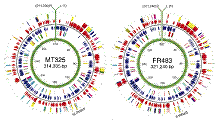Virology, Nebraska Center for
Document Type
Article
Date of this Version
2005
Citation
Methods Mol Med. 2005 ; 119: 247–260.
Abstract
Improvements in methodologies to recapitulate and study particular biological functions of the
papillomavirus life cycle have led to great advances in our knowledge of these viruses. Described in
this chapter are techniques that allow low-copy and high-copy replication of full-length human
papillomavirus (HPV) genomes, as well as assembly of virus-like particles, in Saccharomyces
cerevisiae (yeast). This system has several distinct advantages that make it an attractive complement
to the well-established raft-culturing system. First, yeast are inexpensive, rapid, and simple to culture
in the lab. Second, they provide an ever-widening array of genetic tools to analyze HPV functions
—most recently notable, the yeast ORF-deletion library. Third, yeast provide a potentially high efficiency
means to produce large quantities of infectious virus in a short time frame. Fourth,
assembly of HPV virus in yeast allows encapsidation of mutant genomes, since previous studies have
shown that no viral ORF is required for replication of full-length HPV in yeast.
Included in
Biological Phenomena, Cell Phenomena, and Immunity Commons, Cell and Developmental Biology Commons, Genetics and Genomics Commons, Infectious Disease Commons, Medical Immunology Commons, Medical Pathology Commons, Virology Commons


Comments
Copyright 2005 Angeletti.